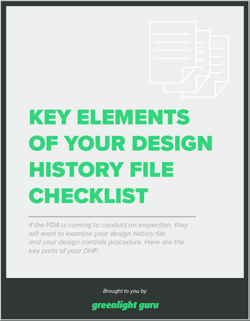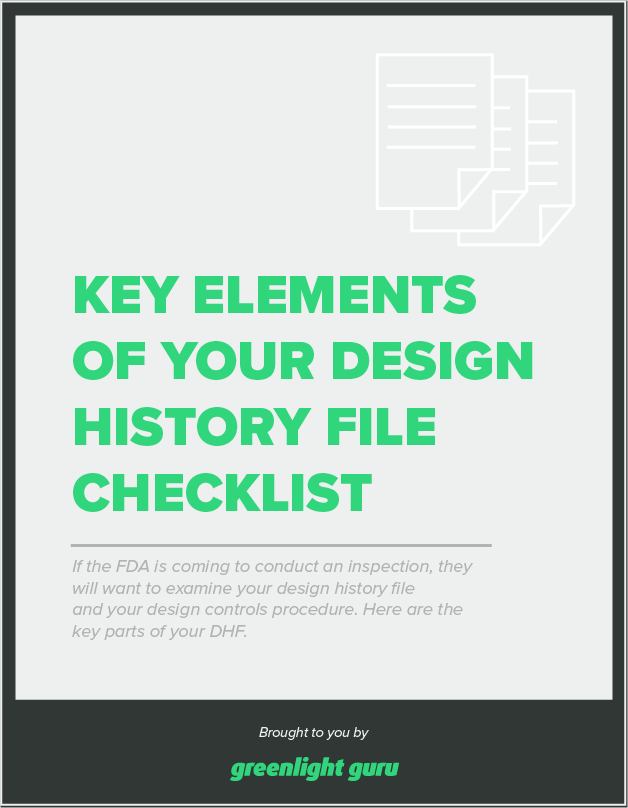3 Tips for Managing Your Medical Device Design History File

Your design history file (DHF) is one of the most critical components of your QMS. That’s because the DHF should contain all the product development documentation for a specific medical device.
Its purpose is to show regulatory bodies and internal stakeholders that you appropriately followed the design control process during product development. It’s also proof that your medical device was developed according to the design plan.
FDA inspectors are guaranteed to look through it during an inspection, and even a single missing signature can get you written up.
With so much riding on it, you need a plan in place to store and manage all of the documentation that goes into your DHF. It may feel like an overwhelming task to keep your design history file audit-ready at all times, but there are a few basic steps you can take to keep it organized and ready for inspection at any time.
1. Prioritize building your traceability matrix
Your DHF requires an enormous amount of documentation about your product’s development and your design controls. To make sure this documentation is fully connected, traceable, and easy to find, you need to build a traceability matrix.
A traceability matrix is simply a visual representation of the links between different areas in your DHF, like user needs, design inputs, and design outputs, and creates clear paths from the physical product to the design history.
Your traceability matrix is the roadmap to your design history file. Without it, you run the risk of missing something critical during development.
One of the biggest mistakes you can make when it comes to your DHF is leaving the creation of your traceability matrix until the very end. Doing so may even cause you to miss something that could delay your product launch—like a biocompatibility test that should have been carried out early in development.
2. Keep your DHF up to date—throughout the entire product lifecycle
FDA mandates that each manufacturer “shall establish and maintain a DHF for each type of device.” The operative word here is maintain.
Your DHF is a living document. As you work through product development, you’ll be adding to it in the form of documentation of your design controls and the execution of your design plan. However, your responsibilities don’t end once product development is over.
For instance, there’s a good chance you’ll need to make a change to your device after it goes to market. Your postmarket surveillance activities may indicate that you need to refine some aspect of your device’s design or perhaps change one of the materials you use, and any design changes must be documented within your DHF.
This is where your traceability matrix becomes crucial, as it provides you with a guide to which design outputs and specifications will be affected by the change and their relationship to applicable design inputs and requirements. You’ll also need to document any new verification and validation activities you carry out as part of the change.
Simply put, the DHF must be maintained and updated as long as your product is on the market.
3. Integrate risk management into your design history file
It’s critical for medical device manufacturers to understand that design controls and risk management are not separate processes. They are inextricably linked and should be carried out together, as part of a larger focus on true quality.
You need only look at the risk control process to understand that there is an intimate connection between hazards and hazardous situations and design controls like your design inputs and design outputs.
That’s because once you’ve identified hazardous situations that require risk reduction, you must take measures to control these risks. This will likely result in changes to both the design inputs and design outputs of your device, which are key items in your DHF.
In fact, while many manufacturers leave risk out of the DHF, I recommend that you include your risk analysis, along with your hazard identification, in your design history file.
Automatically maintain full traceability with Greenlight Guru’s Design Control Software
Your DHF is too important to manage with a paper-based system. The chance that you’ll forget a signature, misplace documentation, or fail to keep everything up to date is just too high.
With Greenlight Guru’s Multi-level Design Control Software, however, you can generate design history files on-demand. Because our software automatically provides full traceability, you can produce all of the documents needed at each stage of production and generate your DHF at any time.
If you’re ready to stop wasting time manually searching for the documents you need for your DHF, then get your free demo of Greenlight Guru today!
Tom Rish is a Medical Device Guru at Greenlight Guru who works with customers to utilize their QMS software to build safer products on expedited timelines. He is a Biomedical Engineer who began his career developing implant and instrument systems in the orthopedic industry. He enjoys helping customers successfully...
Related Posts
How to Prepare Your Design History File (DHF) for an FDA Inspection
Design History File (DHF) vs. Device Master Record (DMR) vs. Device History Record (DHR): What's the Difference?
Technical File vs. 510(k) vs. Design History File: What Medical Device Developers Should Know
Get your free PDF
Checklist: Key Elements to Include in Your Design History File










